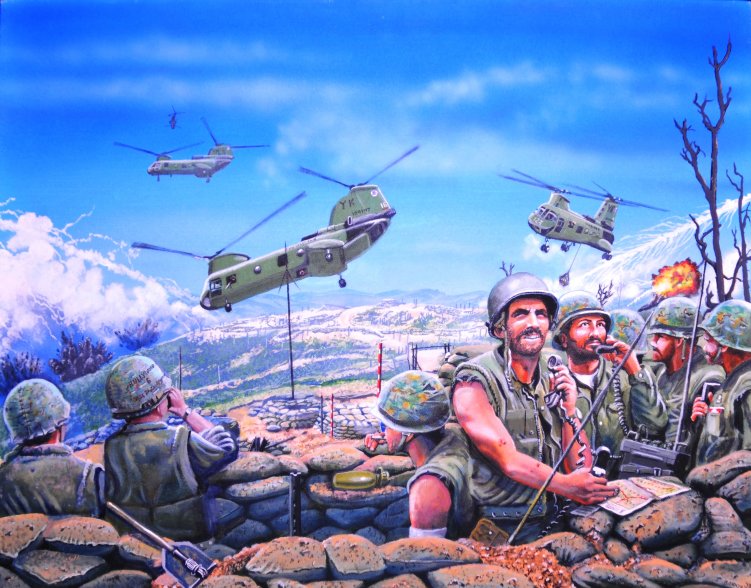
In 1968 the Marine air base in the Khe Sanh valley of Vietnam was protected by a necklace of surrounding hilltop fire bases, the most strategically important being Hill 881 South. Two reinforced companies, Mike and India of the 3rd Battalion, 26th Marines, dug in atop the ridge, surrounded by thousands of North Vietnamese regulars with heavy mortars and artillery. Anything above ground level in daylight hours was soon shredded by shrapnel from the almost continuous bombardment. The Marines joked that there were only two ways off the hill, “Flown off or blown off.”
Once the enemy knew which of the five landing zones a helicopter was headed for, the pilot had about 14 seconds on the ground to deliver supplies and replacement troops and take on the dead and wounded before the first mortar rounds hit. In the opening month of the siege, seven helicopters were lost.
Then someone in the air wing conceived of the “Supergaggle,” an astonishing feat of air-ground coordination. Every three days, weather permitting, two F4 Skyhawks streaked along either side of the hill attacking known antiaircraft sites and laying down a dense wall of white phosphorous smoke to blind the enemy. They then pounded those dug in on the flanks of 881 South itself, delivering napalm right up to the Marines’ perimeter wire. While the North Vietnamese Army (NVA) was blinded and preoccupied, five CH-46 cargo helicopters of the “Purple Foxes,” HMM 364, flew down the corridor between the walls of smoke and fire, executed a maneuver which in marching would be called, “By the right flank, march!” and dropped their external loads at the 5 LZs. Immediately behind came five more with one designated to land, drop fresh troops and collect the dead and wounded. While brilliantly successful, the inherent danger of resupplying the hill meant that food was soon rationed to one meal a day and water to eight ounces per man per day.
After three months the NVA gave up its siege of the Khe Sanh valley. The defenders of Hill 881 South had sustained 95% casualties: of the original 400, about 19 were not killed or wounded. They departed the hill bearded, scrawny, wobbling as they walked, utterly filthy with their clothes rotting off of them, but in high spirits.
In this painting, we are looking west from India Company’s trenches toward Mike Company’s position with the Laotian border visible in the distance. The Khe Sanh valley is behind us. The central figure is the hill commander, Capt. Bill Dabney, the “India Six” who wore a helmet without a camo cover so the troops could identify him without enemy snipers doing the same. The map in front of him is laid sideways so it is oriented toward true North. Beside him is Cpl. Robert Arrotta, his forward air controller, managing the “Supergaggle.” On the far left is a civilian photographer, Dave Powell, who spent two days recording the drama of the siege at great personal risk. Someone wrote, “Hollywood Six, War photos anyone?” on his helmet cover. The central helicopter, YK-16 was nicknamed “Patches” for the dozens of small arms holes it sustained in support of the besieged grunts. The one to the right, about to drop its net, found that servicing the hill required all the luck it could get: its number was changed from YK-13 to YK- 12-7/8.
I have taken artistic liberty with the composition: no one would have exposed themselves so openly during the “high air/metal density index” of a Supergaggle.
Robert Arrotta won the Bronze Star for his masterful handling of air power. Dave Powell’s poignant photos are on display in the Pentagon. Bill Dabney retired as a Colonel and was awarded the Navy Cross, second only to the Medal of Honor, as well as earning the immeasurable esteem and gratitude of his surviving troops. I had the honor and pleasure of interviewing him in 2006 for advice when doing a 360-degree mural that surrounds the recreation of Hill 881 South at the National Museum of the Marine Corps, and I had him approve this painting in 2010.